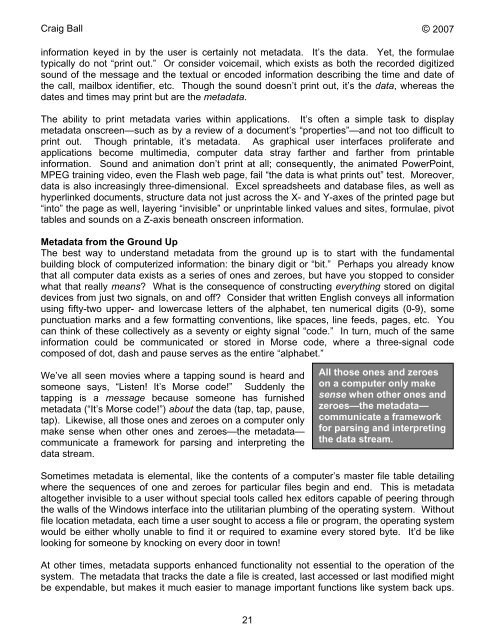Six Articles on Electronic - Craig Ball
Six Articles on Electronic - Craig Ball
Six Articles on Electronic - Craig Ball
You also want an ePaper? Increase the reach of your titles
YUMPU automatically turns print PDFs into web optimized ePapers that Google loves.
<strong>Craig</strong> <strong>Ball</strong> © 2007<br />
informati<strong>on</strong> keyed in by the user is certainly not metadata. It’s the data. Yet, the formulae<br />
typically do not “print out.” Or c<strong>on</strong>sider voicemail, which exists as both the recorded digitized<br />
sound of the message and the textual or encoded informati<strong>on</strong> describing the time and date of<br />
the call, mailbox identifier, etc. Though the sound doesn’t print out, it’s the data, whereas the<br />
dates and times may print but are the metadata.<br />
The ability to print metadata varies within applicati<strong>on</strong>s. It’s often a simple task to display<br />
metadata <strong>on</strong>screen—such as by a review of a document’s “properties”—and not too difficult to<br />
print out. Though printable, it’s metadata. As graphical user interfaces proliferate and<br />
applicati<strong>on</strong>s become multimedia, computer data stray farther and farther from printable<br />
informati<strong>on</strong>. Sound and animati<strong>on</strong> d<strong>on</strong>’t print at all; c<strong>on</strong>sequently, the animated PowerPoint,<br />
MPEG training video, even the Flash web page, fail “the data is what prints out” test. Moreover,<br />
data is also increasingly three-dimensi<strong>on</strong>al. Excel spreadsheets and database files, as well as<br />
hyperlinked documents, structure data not just across the X- and Y-axes of the printed page but<br />
“into” the page as well, layering “invisible” or unprintable linked values and sites, formulae, pivot<br />
tables and sounds <strong>on</strong> a Z-axis beneath <strong>on</strong>screen informati<strong>on</strong>.<br />
Metadata from the Ground Up<br />
The best way to understand metadata from the ground up is to start with the fundamental<br />
building block of computerized informati<strong>on</strong>: the binary digit or “bit.” Perhaps you already know<br />
that all computer data exists as a series of <strong>on</strong>es and zeroes, but have you stopped to c<strong>on</strong>sider<br />
what that really means? What is the c<strong>on</strong>sequence of c<strong>on</strong>structing everything stored <strong>on</strong> digital<br />
devices from just two signals, <strong>on</strong> and off? C<strong>on</strong>sider that written English c<strong>on</strong>veys all informati<strong>on</strong><br />
using fifty-two upper- and lowercase letters of the alphabet, ten numerical digits (0-9), some<br />
punctuati<strong>on</strong> marks and a few formatting c<strong>on</strong>venti<strong>on</strong>s, like spaces, line feeds, pages, etc. You<br />
can think of these collectively as a seventy or eighty signal “code.” In turn, much of the same<br />
informati<strong>on</strong> could be communicated or stored in Morse code, where a three-signal code<br />
composed of dot, dash and pause serves as the entire “alphabet.”<br />
We’ve all seen movies where a tapping sound is heard and<br />
some<strong>on</strong>e says, “Listen! It’s Morse code!” Suddenly the<br />
tapping is a message because some<strong>on</strong>e has furnished<br />
metadata (“It’s Morse code!”) about the data (tap, tap, pause,<br />
tap). Likewise, all those <strong>on</strong>es and zeroes <strong>on</strong> a computer <strong>on</strong>ly<br />
make sense when other <strong>on</strong>es and zeroes—the metadata—<br />
communicate a framework for parsing and interpreting the<br />
data stream.<br />
All those <strong>on</strong>es and zeroes<br />
<strong>on</strong> a computer <strong>on</strong>ly make<br />
sense when other <strong>on</strong>es and<br />
zeroes—the metadata—<br />
communicate a framework<br />
for parsing and interpreting<br />
the data stream.<br />
Sometimes metadata is elemental, like the c<strong>on</strong>tents of a computer’s master file table detailing<br />
where the sequences of <strong>on</strong>e and zeroes for particular files begin and end. This is metadata<br />
altogether invisible to a user without special tools called hex editors capable of peering through<br />
the walls of the Windows interface into the utilitarian plumbing of the operating system. Without<br />
file locati<strong>on</strong> metadata, each time a user sought to access a file or program, the operating system<br />
would be either wholly unable to find it or required to examine every stored byte. It’d be like<br />
looking for some<strong>on</strong>e by knocking <strong>on</strong> every door in town!<br />
At other times, metadata supports enhanced functi<strong>on</strong>ality not essential to the operati<strong>on</strong> of the<br />
system. The metadata that tracks the date a file is created, last accessed or last modified might<br />
be expendable, but makes it much easier to manage important functi<strong>on</strong>s like system back ups.<br />
21













